
















Grandpappy's Basic Recipes
A Collection of
Wild Game Recipes
Copyright © 1976,2007 by Robert Wayne Atkins, P.E.
All Rights Reserved.
A wise person will not form an opinion about the taste of a specific type of wild animal until after he or she has had an opportunity to actually eat some of it after the meat has been properly prepared following a traditional recipe. Each of us has different taste preferences and you may discover that some of the following wild game recipes are actually quite delightful.
General Instructions for Processing Wild Game
- Always wear gloves (latex or rubber) when processing wild game. Wild animals may be caring diseases such as trichinosis, or tularemia, or salmonella, and the gloves will protect you from these potential diseases while handling the dead animals. If the meat is thoroughly cooked, then it can be safely eaten even if these diseases may have been present in the raw meat.
- Process the dead animal as soon as possible after it has been slain:
- Drain off all the blood by cutting the left jugular neck vein, or cut off and remove the animal's head. Hang small animals upside down by their hind legs, or arrange larger animals so they are facing downhill on a slope.
- Carefully remove all the internal organs without spilling their contents on the meat. Discard all the internal organs (except the ones you know are edible).
- Most smaller animals (groundhog, opossum, porcupine, raccoon, squirrel) have glands that are located in their small of the back and under each foreleg. Locate, remove and discard those glands. (Note: Groundhogs have seven or eight of these small glands.)
- Skin the animal and remove all the fat. The fat will turn rancid very quickly and it must be discarded (or it should be processed immediately).
- Do not let the exterior hair or fur of the animal touch its inner meat as it may transmit an undesirable flavor to the meat. If any loose animal hair accidentally falls on the meat, remove and discard the hair immediately.
- If the animal was shot, remove and discard any bullet damaged meat and dried blood from the bullet wound area.
- Clean and cool the meat as quickly as you can. Plastic freezer bags may be filled with ice, snow, or cold creek water. The meat of small animals may be placed between the sealed bags. Or the sealed bags may be placed inside the body cavity of larger animals. If no cooling bags are available, prop open the body cavity of larger animals with some sticks.
- The meat of wild animals should be well cooked to help make it safe to eat (similar to pork).
- Small animals (such as rabbit or muskrat) may be processed in a manner similar to chicken.
- Large animals (such as deer or bear) may be processed in a manner similar to beef.
Additional Processing Instructions for Small Game Animals
Armadillo - (The size of a large house cat.) - Break the outer shell of the armadillo and only remove the edible back meat. Remove and discard any fat clinging to the back meat. Wash in cool water. Then place the back meat in a pot of cool water and allow it to soak for 12 hours inside the refrigerator. Drain and dry. Cut into bite size pieces and dip in oil. Place the meat onto meat skewers and broil slowly over the heat of a campfire.
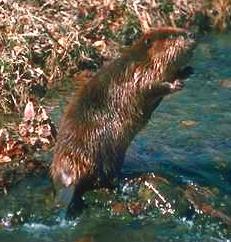 Beaver - (35 to 65 pounds, 3 to 4 feet long, flat tail) - Carefully remove the two musk glands that are located under the skin in front of the genital area. Hang the gutted beaver in a cool dry area for two days. Place the meat in a covered pot of salted cold water with a vented lid and simmer for 60 minutes. The steam should be allowed to escape through the vent in the pot lid. (If necessary, add more water during the simmering process.) Cut the meat into steak size slices and cook in a skillet containing 1/2 inch of water over low heat. Turn the steaks over frequently so each side cooks slowly. Continue to cook until they are well done.
Beaver - (35 to 65 pounds, 3 to 4 feet long, flat tail) - Carefully remove the two musk glands that are located under the skin in front of the genital area. Hang the gutted beaver in a cool dry area for two days. Place the meat in a covered pot of salted cold water with a vented lid and simmer for 60 minutes. The steam should be allowed to escape through the vent in the pot lid. (If necessary, add more water during the simmering process.) Cut the meat into steak size slices and cook in a skillet containing 1/2 inch of water over low heat. Turn the steaks over frequently so each side cooks slowly. Continue to cook until they are well done.
Beaver Tail - Position the tail over the flames of a campfire until the skin blisters. Remove the tail from the heat and allow it to cool. Then peel off the tail skin. The beaver tail may now be roasted over campfire coals, or it may be simmered in a skillet containing 1/2 inch of water until it is tender.
 Groundhog, also called a Woodchuck - (10 to 20 pounds, 2 feet long) - Hang the gutted groundhog in a cool dry area for two days. Then place it in a pot of salted water and allow to soak for 12 hours inside the refrigerator. Drain. The groundhog meat may now be used in a recipe in place of chicken. For example, cut-up groundhog pieces may be coated with salt, pepper, and flour, and then fried in a skillet like chicken. For southern fried and northern fried chicken recipes please click on the following link: Meat Recipes.
Groundhog, also called a Woodchuck - (10 to 20 pounds, 2 feet long) - Hang the gutted groundhog in a cool dry area for two days. Then place it in a pot of salted water and allow to soak for 12 hours inside the refrigerator. Drain. The groundhog meat may now be used in a recipe in place of chicken. For example, cut-up groundhog pieces may be coated with salt, pepper, and flour, and then fried in a skillet like chicken. For southern fried and northern fried chicken recipes please click on the following link: Meat Recipes.
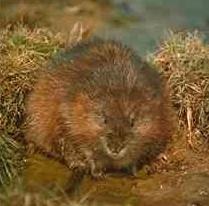 Muskrat - (2 to 3 pounds, 10 inches long) - Only the hams and shoulders of the muskrat are edible. Remove and discard the musk glands located below the stomach and legs, along with the white stringy meat attached to the musk glands. Place the hams and shoulders in a covered pot of salted cold water with a vented lid and simmer for 45 minutes. The steam should be allowed to escape through the vent in the pot lid. (If necessary, add more water during the simmering process.) Drain. The muskrat meat may now be used in a recipe. For example, place the cut-up muskrat meat into a Dutch oven with 1 cup of water, 1 small chopped onion, 1/2 teaspoon salt, and 1/2 teaspoon thyme. Cover and simmer until the meat is tender and well done.
Muskrat - (2 to 3 pounds, 10 inches long) - Only the hams and shoulders of the muskrat are edible. Remove and discard the musk glands located below the stomach and legs, along with the white stringy meat attached to the musk glands. Place the hams and shoulders in a covered pot of salted cold water with a vented lid and simmer for 45 minutes. The steam should be allowed to escape through the vent in the pot lid. (If necessary, add more water during the simmering process.) Drain. The muskrat meat may now be used in a recipe. For example, place the cut-up muskrat meat into a Dutch oven with 1 cup of water, 1 small chopped onion, 1/2 teaspoon salt, and 1/2 teaspoon thyme. Cover and simmer until the meat is tender and well done.
Opossum - (4 to 10 pounds, 3 feet long, long pointed noise, rat like tail) - Remove the internal organs of the opossum but do not skin it. Place the unskinned opossum in a pot of water and place the pot over the heat. Do not allow the water to boil. Periodically pull on the opossum's hair and when the hair comes out easily, remove the opossum from the water. Scrape the opossum and pour cool water over the opossum as you scrape. Remove the small red glands located in the small of the back and under each foreleg, between the shoulder and the ribs. Place the opossum meat in a large pot of cold water and bring slowly to a boil. Do not cover the pot. Allow it to simmer for 20 minutes. Drain. Place the opossum meat in a fresh pot of cold water and bring slowly to a boil. Do not cover the pot. Allow it to simmer for another 20 minutes. Drain off the hot water and then put the meat into some cold water to make it firm. The opossum meat may now be used in most recipes instead of pork or chicken.
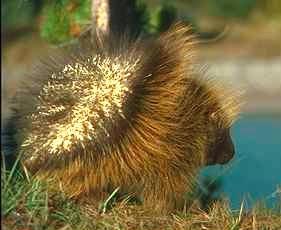 Porcupine - (15 pounds, 3 feet long) - Hang the gutted porcupine in a cool dry area for two days. Then place it in a pot of salted water and allow the porcupine meat to soak for 12 hours inside the refrigerator. Remove the pot from the refrigerator. Place the pot over medium heat and bring to a boil. Drain and then put the meat into another pot of cold water and bring it to a boil. Drain. The porcupine meat may now be used in a recipe. For example, place the cut-up porcupine meat in a Dutch oven with 3 cups of water, 1/2 teaspoon pepper, 1 teaspoon salt, and some chopped onions and/or celery. Simmer for 2.5 hours.
Porcupine - (15 pounds, 3 feet long) - Hang the gutted porcupine in a cool dry area for two days. Then place it in a pot of salted water and allow the porcupine meat to soak for 12 hours inside the refrigerator. Remove the pot from the refrigerator. Place the pot over medium heat and bring to a boil. Drain and then put the meat into another pot of cold water and bring it to a boil. Drain. The porcupine meat may now be used in a recipe. For example, place the cut-up porcupine meat in a Dutch oven with 3 cups of water, 1/2 teaspoon pepper, 1 teaspoon salt, and some chopped onions and/or celery. Simmer for 2.5 hours.
 Rabbit - (2 to 3 pounds) - Place the skinned cleaned rabbit in a pot of salted water and allow the meat to soak for 12 hours inside the refrigerator. Rabbit may be used in place of chicken in almost any recipe. For example, cut-up rabbit pieces may be coated with salt, pepper, and flour, and then fried in a skillet like chicken. For southern fried and northern fried chicken recipes please click on the following link: Meat Recipes.
Rabbit - (2 to 3 pounds) - Place the skinned cleaned rabbit in a pot of salted water and allow the meat to soak for 12 hours inside the refrigerator. Rabbit may be used in place of chicken in almost any recipe. For example, cut-up rabbit pieces may be coated with salt, pepper, and flour, and then fried in a skillet like chicken. For southern fried and northern fried chicken recipes please click on the following link: Meat Recipes.
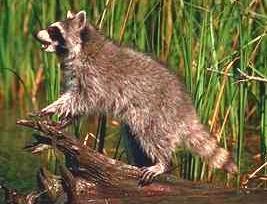 Raccoon, also called a Coon - (15 pounds, 2 to 3 feet long, black mask around the eyes) - After removing all the fat on the outside and inside of the raccoon, place it in a pot of salted water and allow the meat to soak for 12 hours inside the refrigerator. Remove the pot from the refrigerator. Place the pot over medium heat and slowly bring the water to a boil. Then allow it to simmer for 45 minutes, without covering the pot. Add two tablespoons of baking soda to the water and continue to simmer for another five minutes. Drain off the hot water and then put the raccoon meat in a fresh pot of cold water and slowly bring to a boil. Allow it to simmer for 15 minutes. Drain off the hot water and then put the meat into some cold water to make it firm. The raccoon meat may now be used in most recipes instead of pork. For example, the raccoon may be roasted over a campfire so the fat will drip down into the fire.
Raccoon, also called a Coon - (15 pounds, 2 to 3 feet long, black mask around the eyes) - After removing all the fat on the outside and inside of the raccoon, place it in a pot of salted water and allow the meat to soak for 12 hours inside the refrigerator. Remove the pot from the refrigerator. Place the pot over medium heat and slowly bring the water to a boil. Then allow it to simmer for 45 minutes, without covering the pot. Add two tablespoons of baking soda to the water and continue to simmer for another five minutes. Drain off the hot water and then put the raccoon meat in a fresh pot of cold water and slowly bring to a boil. Allow it to simmer for 15 minutes. Drain off the hot water and then put the meat into some cold water to make it firm. The raccoon meat may now be used in most recipes instead of pork. For example, the raccoon may be roasted over a campfire so the fat will drip down into the fire.
Squirrel Recipes - Since squirrels are common in many places, including residential neighborhoods, there is a special web page dedicated to these small animals. Please click on this link: Squirrel Recipes.
Broiling Meats over a Campfire
Sear the flesh of the animal over open flames before cooking. This keeps the juices and nutrients inside the animal.
Grilling Meats
Meats retain their juices better if they are turned 4 or 5 times while cooking. Turn meat with tongs not forks. Cook on grilling rack about 4 to 6 inches directly above the hot coals. The meat will cook quickly. Watch it closely.
Pan Steaks
Melt some fat in the frying pan. Salt and flour the steaks and put them in the pan. When the meat is almost ready, make some pan gravy by stirring a little flour in with the hot grease. Add a little water and stir to make pan gravy.
Wild Game Stew
Gut and skin the animal (deer, bear, beaver, raccoon, rabbit, porcupine, opossum) (or dog, cat, or something even less desirable in an emergency survival situation). Parboil the meat for about 10 minutes, allow it to cool, and then remove the meat from the bones. If present, cut off some fat and put it in the pot. While the fat is melting, cube the heart into small pieces and add it first. Skin the tongue and cube it and add it to the pot. This gives the 2 toughest pieces a longer time to cook. Cut up the liver and tenderloin and add them to the pot. Now cover everything with warm water and let it simmer. Add salt, pepper, and onion. Cooking time is three hours. The final stew is delicious.
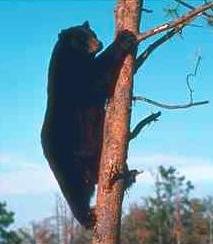 Bear Meat
Bear Meat
An adult black bear will weigh around 400 or 500 pounds. Bear should be hunted in the fall after it has had a chance to feed for an entire spring and summer. Do not hunt bear in the spring when it just becoming active after its winter hibernation, because it will have lost a lot of weight and it may be somewhat parasitic.
Bear meat is relatively greasy and it may be used in place of pork or beef in recipes. After eating a properly prepared bear steak, some people have discovered they prefer the flavor of bear meat to beef.
Bear Fat
Properly rendered bear fat may be used in recipes in place of butter. Bear fat is richer than butter and therefore you should use a little less of it than the amount of butter specified in the recipe.
Remove the fat from the bear as soon as possible after the death of the bear. The fat will become rancid VERY quickly if it is not processed immediately. Cut the fat into small pieces and heat it slowly in a heavy large pot or pan that contains a small quantity of fresh water. If necessary, press down on the fat with a spoon to help it melt faster. After the fat has melted remove it from the heat and allow it to cool just a little. While it is still warm pour it through a cheesecloth and then store the melted fat in the refrigerator in a plastic storage container with a tight fitting lid.
The brown residue in the top of the cheesecloth is called "cracklings" and it may be saved and used as a flavoring in recipes.
Black Bear Roast
Slice bear meat into boneless one-pound steaks or into boneless roasts weighing between three to five pounds each. Allow the meat to soak overnight in the refrigerator in a marinade of four parts salted water to one part olive oil (or salad oil). Place the roast on a cooking rack that is one or two inches above the inside bottom of the roasting pan. Pour the marinade into the roasting pan on top of the roast. Add your favorite vegetables, such as sliced carrots, quartered potatoes, diced celery, or sliced onion. Add salt and pepper as desired. Bake in a 350°F oven for 90 minutes and then turn the roast over. Return to oven and bake an additional 90 minutes. Test to see if the meat is well done. In necessary, continue to cook for another 30 to 60 minutes. Remove roast and roasting rack from bottom of roasting pan. Set any vegetables aside. Pour remaining broth from roasting pan into a cook pot and bring to a boil on top of the stove. Add about 1/2 cup flour and stir to make gravy. Slice roast and cover with gravy and serve with vegetables.
Deer Meat (Venison)
Deer meat is very lean meat and it may be cooked, roasted, or broiled in the same manner as beef. It may be substituted for beef in almost any recipe. However, since it is a very lean meat it may require the addition of some fat or oil to the recipe.
Bone Marrow
The center of a bone contains marrow and it is edible. It is present in reasonable quantities in the spine and in the other large bones of game animals. The larger bones can be split and the marrow removed. Larger pieces of bone marrow may cut into 1/2 inch thick slices and then poached for 2 minutes, or it may be heated briefly in the top part of a double boiler.
Soup bones are frequently added to soup recipes to add nutrients and flavor. The bones are removed before serving the soup.
Grandpappy's e-mail address is: RobertWayneAtkins@hotmail.com




































 Beaver - (35 to 65 pounds, 3 to 4 feet long, flat tail) - Carefully remove the two musk glands that are located under the skin in front of the genital area. Hang the gutted beaver in a cool dry area for two days. Place the meat in a covered pot of salted cold water with a vented lid and simmer for 60 minutes. The steam should be allowed to escape through the vent in the pot lid. (If necessary, add more water during the simmering process.) Cut the meat into steak size slices and cook in a skillet containing 1/2 inch of water over low heat. Turn the steaks over frequently so each side cooks slowly. Continue to cook until they are well done.
Beaver - (35 to 65 pounds, 3 to 4 feet long, flat tail) - Carefully remove the two musk glands that are located under the skin in front of the genital area. Hang the gutted beaver in a cool dry area for two days. Place the meat in a covered pot of salted cold water with a vented lid and simmer for 60 minutes. The steam should be allowed to escape through the vent in the pot lid. (If necessary, add more water during the simmering process.) Cut the meat into steak size slices and cook in a skillet containing 1/2 inch of water over low heat. Turn the steaks over frequently so each side cooks slowly. Continue to cook until they are well done. Groundhog, also called a Woodchuck - (10 to 20 pounds, 2 feet long) - Hang the gutted groundhog in a cool dry area for two days. Then place it in a pot of salted water and allow to soak for 12 hours inside the refrigerator. Drain. The groundhog meat may now be used in a recipe in place of chicken. For example, cut-up groundhog pieces may be coated with salt, pepper, and flour, and then fried in a skillet like chicken. For southern fried and northern fried chicken recipes please click on the following link: Meat Recipes.
Groundhog, also called a Woodchuck - (10 to 20 pounds, 2 feet long) - Hang the gutted groundhog in a cool dry area for two days. Then place it in a pot of salted water and allow to soak for 12 hours inside the refrigerator. Drain. The groundhog meat may now be used in a recipe in place of chicken. For example, cut-up groundhog pieces may be coated with salt, pepper, and flour, and then fried in a skillet like chicken. For southern fried and northern fried chicken recipes please click on the following link: Meat Recipes. Muskrat - (2 to 3 pounds, 10 inches long) - Only the hams and shoulders of the muskrat are edible. Remove and discard the musk glands located below the stomach and legs, along with the white stringy meat attached to the musk glands. Place the hams and shoulders in a covered pot of salted cold water with a vented lid and simmer for 45 minutes. The steam should be allowed to escape through the vent in the pot lid. (If necessary, add more water during the simmering process.) Drain. The muskrat meat may now be used in a recipe. For example, place the cut-up muskrat meat into a Dutch oven with 1 cup of water, 1 small chopped onion, 1/2 teaspoon salt, and 1/2 teaspoon thyme. Cover and simmer until the meat is tender and well done.
Muskrat - (2 to 3 pounds, 10 inches long) - Only the hams and shoulders of the muskrat are edible. Remove and discard the musk glands located below the stomach and legs, along with the white stringy meat attached to the musk glands. Place the hams and shoulders in a covered pot of salted cold water with a vented lid and simmer for 45 minutes. The steam should be allowed to escape through the vent in the pot lid. (If necessary, add more water during the simmering process.) Drain. The muskrat meat may now be used in a recipe. For example, place the cut-up muskrat meat into a Dutch oven with 1 cup of water, 1 small chopped onion, 1/2 teaspoon salt, and 1/2 teaspoon thyme. Cover and simmer until the meat is tender and well done. Porcupine - (15 pounds, 3 feet long) - Hang the gutted porcupine in a cool dry area for two days. Then place it in a pot of salted water and allow the porcupine meat to soak for 12 hours inside the refrigerator. Remove the pot from the refrigerator. Place the pot over medium heat and bring to a boil. Drain and then put the meat into another pot of cold water and bring it to a boil. Drain. The porcupine meat may now be used in a recipe. For example, place the cut-up porcupine meat in a Dutch oven with 3 cups of water, 1/2 teaspoon pepper, 1 teaspoon salt, and some chopped onions and/or celery. Simmer for 2.5 hours.
Porcupine - (15 pounds, 3 feet long) - Hang the gutted porcupine in a cool dry area for two days. Then place it in a pot of salted water and allow the porcupine meat to soak for 12 hours inside the refrigerator. Remove the pot from the refrigerator. Place the pot over medium heat and bring to a boil. Drain and then put the meat into another pot of cold water and bring it to a boil. Drain. The porcupine meat may now be used in a recipe. For example, place the cut-up porcupine meat in a Dutch oven with 3 cups of water, 1/2 teaspoon pepper, 1 teaspoon salt, and some chopped onions and/or celery. Simmer for 2.5 hours. Rabbit - (2 to 3 pounds) - Place the skinned cleaned rabbit in a pot of salted water and allow the meat to soak for 12 hours inside the refrigerator. Rabbit may be used in place of chicken in almost any recipe. For example, cut-up rabbit pieces may be coated with salt, pepper, and flour, and then fried in a skillet like chicken. For southern fried and northern fried chicken recipes please click on the following link: Meat Recipes.
Rabbit - (2 to 3 pounds) - Place the skinned cleaned rabbit in a pot of salted water and allow the meat to soak for 12 hours inside the refrigerator. Rabbit may be used in place of chicken in almost any recipe. For example, cut-up rabbit pieces may be coated with salt, pepper, and flour, and then fried in a skillet like chicken. For southern fried and northern fried chicken recipes please click on the following link: Meat Recipes. Raccoon, also called a Coon - (15 pounds, 2 to 3 feet long, black mask around the eyes) - After removing all the fat on the outside and inside of the raccoon, place it in a pot of salted water and allow the meat to soak for 12 hours inside the refrigerator. Remove the pot from the refrigerator. Place the pot over medium heat and slowly bring the water to a boil. Then allow it to simmer for 45 minutes, without covering the pot. Add two tablespoons of baking soda to the water and continue to simmer for another five minutes. Drain off the hot water and then put the raccoon meat in a fresh pot of cold water and slowly bring to a boil. Allow it to simmer for 15 minutes. Drain off the hot water and then put the meat into some cold water to make it firm. The raccoon meat may now be used in most recipes instead of pork. For example, the raccoon may be roasted over a campfire so the fat will drip down into the fire.
Raccoon, also called a Coon - (15 pounds, 2 to 3 feet long, black mask around the eyes) - After removing all the fat on the outside and inside of the raccoon, place it in a pot of salted water and allow the meat to soak for 12 hours inside the refrigerator. Remove the pot from the refrigerator. Place the pot over medium heat and slowly bring the water to a boil. Then allow it to simmer for 45 minutes, without covering the pot. Add two tablespoons of baking soda to the water and continue to simmer for another five minutes. Drain off the hot water and then put the raccoon meat in a fresh pot of cold water and slowly bring to a boil. Allow it to simmer for 15 minutes. Drain off the hot water and then put the meat into some cold water to make it firm. The raccoon meat may now be used in most recipes instead of pork. For example, the raccoon may be roasted over a campfire so the fat will drip down into the fire.

